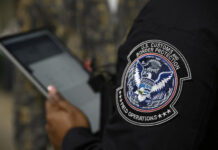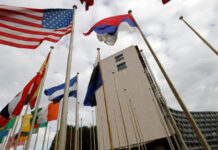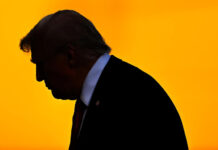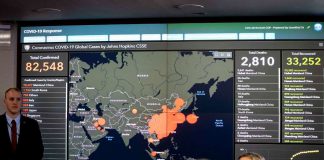SEPTEMBER 13, 2018
 President Donald Trump tosses paper towels into a crowd as he hands out supplies for Hurricane Maria victims in Guaynabo, Puerto Rico, on Oct. 3, 2017.
President Donald Trump tosses paper towels into a crowd as he hands out supplies for Hurricane Maria victims in Guaynabo, Puerto Rico, on Oct. 3, 2017.
When President Trump arrived in Puerto Rico in October, about two weeks after Hurricane Maria hit the island, the commonwealth was still in the early stages of its recovery. Days after he left, only 10 percent of the island had power, only a quarter of cellphone towers were operational and only half the island had running water. A report from the Government Accountability Office released this month noted various reasons for the slow recovery, including a lack of resources, difficult terrain and crippled infrastructure.
During that visit, Trump praised the efforts of federal workers to aid the island and celebrated the low death toll. At the time, 16 people were counted in the official death toll — but this was well before much of the island had been thoroughly assessed, much less aided or restored to normal. By the time Trump was on Air Force One headed back to Washington, the number of people reported to have died as a result of the storm had more than doubled, to 45.
As weeks and months passed and as the island slowly restored power and water, the effects of the storm were still being felt. No power meant no electronic transactions. Limited passability on roads (noted in the GAO report) meant more difficulty in getting to doctors’ offices and hospitals.
In May, The Washington Post reported on the death of Ivette Leon. She had been assisting the recovery effort but fell ill with diverticulitis. She visited a hospital and was given medicine, but she didn’t improve. The next morning, she was short of breath and her family struggled to call for help. It took 20 minutes to get a cell signal. It took ambulances an unusually long time to arrive because traffic signals were out, leading to congestion. By the time the ambulance arrived, Leon was dead.
She died Nov. 29, nearly two months after Trump’s visit.
On Thursday morning, Trump tried to dismiss the death toll of 2,975 adopted by island officials last month following research by George Washington University.
Shortly after the storm struck the island, The Post spoke with University of Delaware professors Joe Trainor and Benigno Aguirre, who work with the school’s Disaster Recovery Center. We wondered how difficult it would be to determine the actual number of deaths from the storm, and Trainor and Aguirre confirmed that it was far from trivial.
“The reality is, we probably will never know” precisely how many people were killed by the storm, Trainor said. The government itself doesn’t tally this number, relying on death certificates filed by coroners in local jurisdictions. Leon’s death, for example, wasn’t attributed to Maria; it was initially attributed to “diabetes” until the family requested that the document be corrected.
“If the hurricane happened on day one and the death happens two or three days after or during it, it’s more likely those deaths will be counted as a result of the hurricane,” Aguirre said. “On the other hand, if it happened two or three weeks afterward, then you have the problem that perhaps it’s not the case there’s a relationship.” Leon’s case is more obvious than others. If someone has a chronic illness and misses a medication, what’s the cause?
This is in part why the Puerto Rican government accepted the George Washington University research. It assessed how many more deaths there were on the island relative to a normal year for the six months after the storm, reaching that figure of nearly 3,000 additional deaths. It’s not a precise figure, instead representing the most likely value from a range of possible death tolls.
That six-month period of research was longer than normal, incidentally, with researchers anticipating that, by the end of that period, death rates would revert to normal. In lower-income areas, they said at a news conference, those rates were still elevated six months later. That they looked at six months of data is precisely why their analysis was available only “a long time later.”
This is also why Trump’s argument that those who died of old age were just “add(ed) onto the list” is wrong. There is no list. There is a comparison between the number of deaths on the island in the period after Maria and the number of deaths during a normal equivalent period on the island.
Another effort from researchers at the Harvard T.H. Chan School of Public Health and Beth Israel Deaconess Medical Center using a different methodology came up with an estimate of more than 4,000 deaths, again representing part of a range of estimates. That investigation included a survey of nearly 3,300 households in which 38 people had died. Of those 38 deaths, a third were attributed to either interruption of medical services, as Leon experienced, or complications from an injury or illness related to the hurricane.
“The long and short of it is: No matter what system exists, there’s a lot of gray involved in how you will attribute any specific death during this time period,” Trainor said, “whether you decide it’s directly or indirectly related to the event itself.”
That gray area lends itself to political machinations.
“It’s always the possibility of turning it into a political issue,” Aguirre said. “That’s not only in the case of the Trump administration but in many other governments that either minimize or maximize the effects.”
“You don’t want to be the mayor who says there could be 100,000 people dead, and it turns out there are 200,000 people dead,” he continued. “But if you’re the mayor who says there are 100,000 dead and it turns out to be 90, people don’t get mad about that.”
That’s why estimates of damage are usually overstated, not understated. And it’s one reason Trump’s attempt to debate away the Puerto Rican death toll is so unusual.
Trump is taking advantage of the uncertainty, of that gray area for a different sort of political benefit. He wants to undercut questions about the government’s handling of the storm and, having established death toll as a metric for doing that by comparing Maria to Hurricane Katrina — in which more than 1,000 fewer people are estimated to have died — during his visit to the island, he wants to make that death toll seem artificial. It is an estimate. It is not an estimate determined by Democrats.
It’s also worth noting that, in his visit to the island, Trump was told explicitly that the official toll at that point was 16. His tweet suggesting it was as low as six by the time he left makes clear that he is not interested in presenting an accurate picture of the effects of the storm on the island.
We don’t know exactly how many people were killed as a result of the storm, and there’s probably no way to know that figure with precision. Trump’s implication that the estimate of deaths was wildly overstated for political reasons is the mirror opposite of reality.
Trump is clearly wildly understating the death toll for political reasons.
Courtesy/Source: Washington Post







































































































